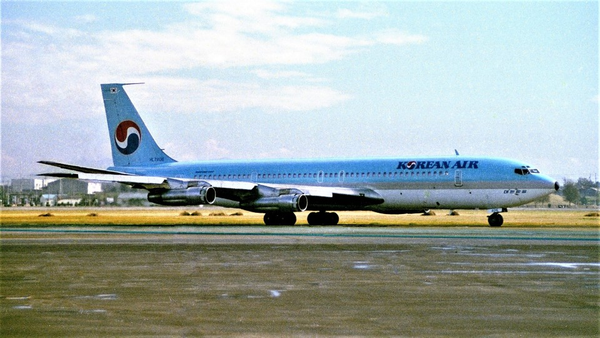On Thursday, October 17th, a mishap occurred at Chicago's O'Hare International airport involving an American Airlines Boeing 787. While taxiing, a cargo container was ingested into the aircraft's number 2 (right) engine and caused substantial damage to both the engine and airframe. No injuries were reported from this incident.

The Incident
American Airlines flight 47 had just arrived in Chicago after a 7 hour and 37 minute flight from London-Heathrow. During the taxi-in from the north runways of O'Hare, the aircraft was on taxiway Bravo, which brings aircraft from the north to the south side of the airport in between terminals 3 and 5. In front of the American Airlines plane was an Airbus A350 operating for Air France, which had also just arrived from Europe. At some point, the A350 in front of the 787 advanced its throttles to move ahead.
Around the same time, an airport service vehicle pulling cargo containers known as unit load devices crossed on the service road that cuts between terminals 3 and 5, and across taxiway Bravo, between the A350 and the 787. A ULD is a container shaped to fit precisely in the cargo hold of an aircraft while allowing smaller items of any type to be placed inside the container. The increased thrust above idle from the A350 blew one of the containers off its mount, and towards the 787.
The ULD was ingested into the number 2 engine (on the right side) of the 787, and caused major internal and external damage to the engine. In addition, shrapnel from the destroyed container caused damage to the airframe itself, although the extent of this damage is still being determined. The aircraft has not flown any flights since the incident.
The Resulting Damage
An aircraft engine ingesting something of this size and makeup is bound to have severe consequences, and the result was nothing short of that. Photos from the incident show large pieces of the ULD shredded around the intake of the number 2 engine on the American 787.
American Airlines has stated that the aircraft has been taken out of service for inspection. Additionally, it's expected that not only will the engine need to be fully replaced, but the aircraft will likely need a full inspection of its fuselage to ensure no punctures occurred on the skin of the aircraft.
Summary
Regardless of the outcome for this incident, it highlights the dangers of moving and being around actively running aircraft. It only takes one miscalculation, one stroke of bad luck or an unforeseen circumstance for dire impacts on the lives of the ground personnel working around the airport, or the safety and structural integrity of an aircraft to be at stake.
The FAA has launched a formal investigation into the cause of how the container got loose, and it will be interesting to see what the official findings are when they do get published.
Ryanair to Appeal $302 Million Italian Fine Over Alleged Travel Agency Restrictions » HEKLA: Icelandair Retires Hekla Aurora After 31 Years in the Skies » Game Day: The Unseen Operation Behind College Sports Travel »
Comments (0)
Add Your Comment
SHARE
TAGS
NEWS AmericanAirlinesAmerican AirlinesBoeing 787787Engine DamageEngineIngestsCargoContainerChicagoChicago AirportRECENTLY PUBLISHED
 VIDEO: What It's Like Onboard China's COMAC C919
We flew onboard China Eastern's COMAC C919 to experience China's homegrown narrow-body up close. From seat comfort to cabin layout to noise levels to tech: how does it really compare with the Boeing 737 and Airbus A320? This review puts all three workhorses under the same spotlight.
TRIP REPORTS
READ MORE »
VIDEO: What It's Like Onboard China's COMAC C919
We flew onboard China Eastern's COMAC C919 to experience China's homegrown narrow-body up close. From seat comfort to cabin layout to noise levels to tech: how does it really compare with the Boeing 737 and Airbus A320? This review puts all three workhorses under the same spotlight.
TRIP REPORTS
READ MORE »
 KAL858: The North Korean Bombing that Shocked the World
Among the 99 passengers boarding Korean Air Flight 858 on November 29, 1987, few could imagine their journey would end as one of aviation's darkest mysteries.
STORIES
READ MORE »
KAL858: The North Korean Bombing that Shocked the World
Among the 99 passengers boarding Korean Air Flight 858 on November 29, 1987, few could imagine their journey would end as one of aviation's darkest mysteries.
STORIES
READ MORE »
 Ghost Networks: The Rise, Fall, and Revival of Fifth-Freedom Flights
Fifth-freedom flights — routes where an airline flies between two countries outside its home base — have always lived in aviation's twilight zone. We chart their rise, their near-disappearance, and the surprising markets where they still thrive today. Then we take you on board a special Seoul-Tokyo fifth-freedom flight to show how the experience stacks up against a typical regional carrier.
TRIP REPORTS
READ MORE »
Ghost Networks: The Rise, Fall, and Revival of Fifth-Freedom Flights
Fifth-freedom flights — routes where an airline flies between two countries outside its home base — have always lived in aviation's twilight zone. We chart their rise, their near-disappearance, and the surprising markets where they still thrive today. Then we take you on board a special Seoul-Tokyo fifth-freedom flight to show how the experience stacks up against a typical regional carrier.
TRIP REPORTS
READ MORE »



